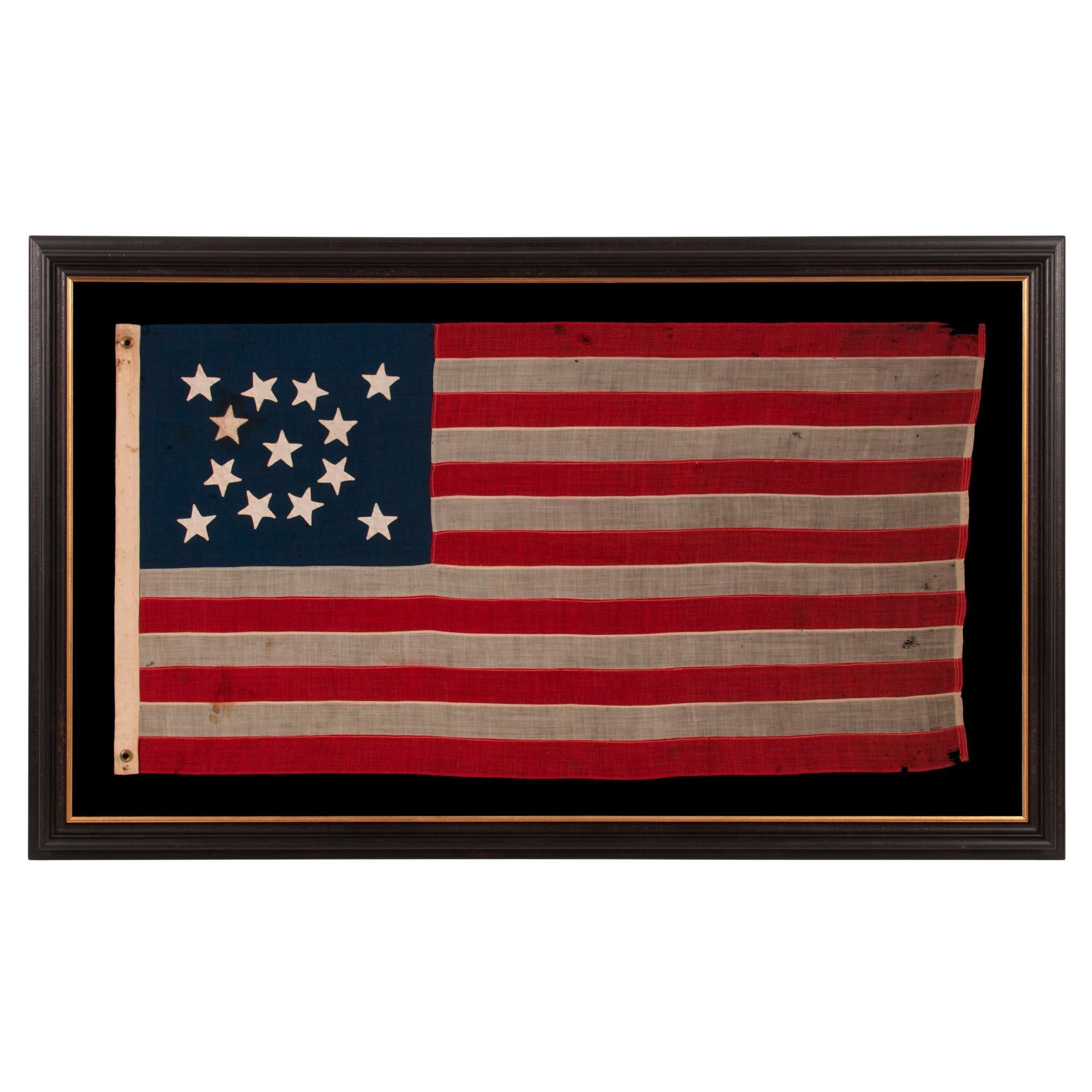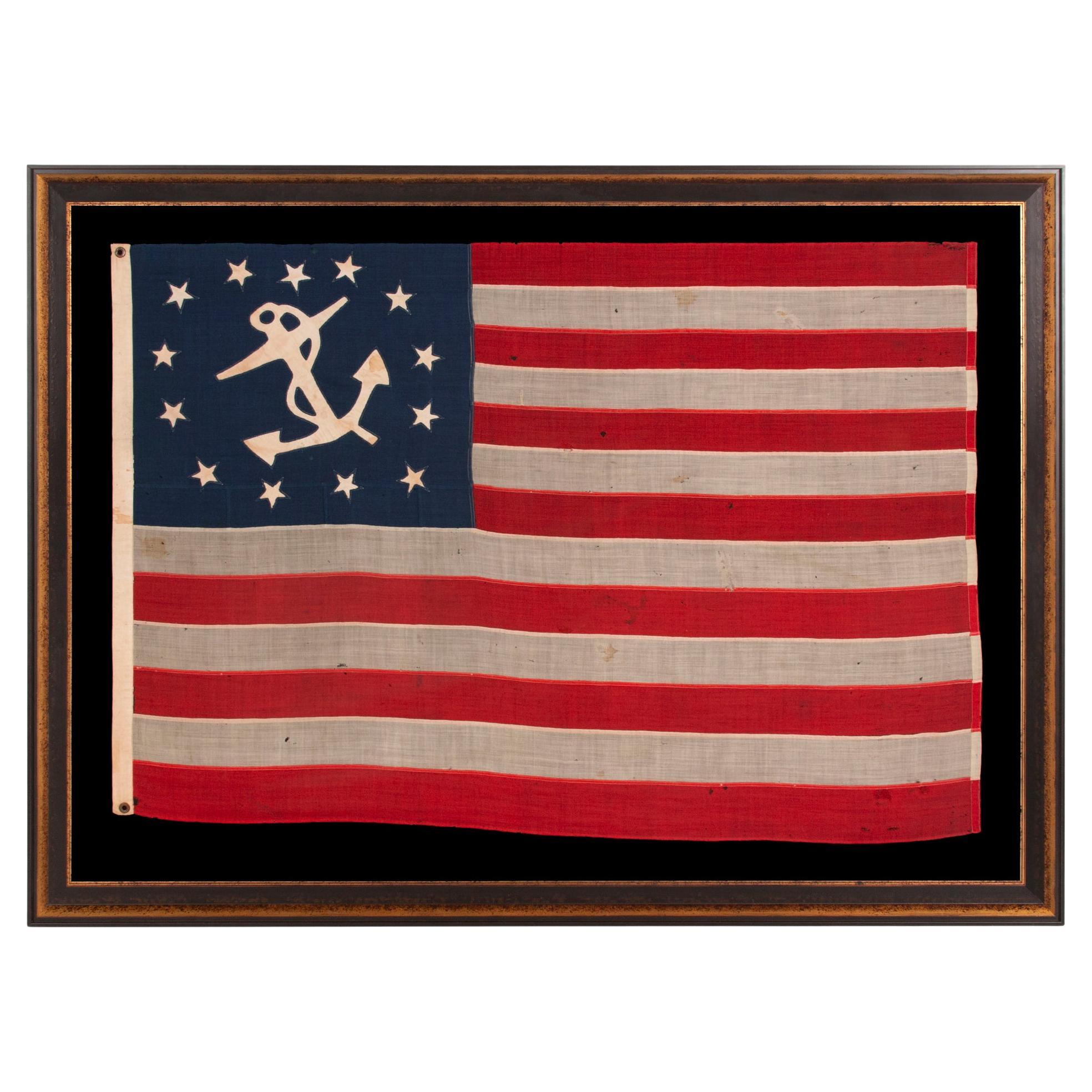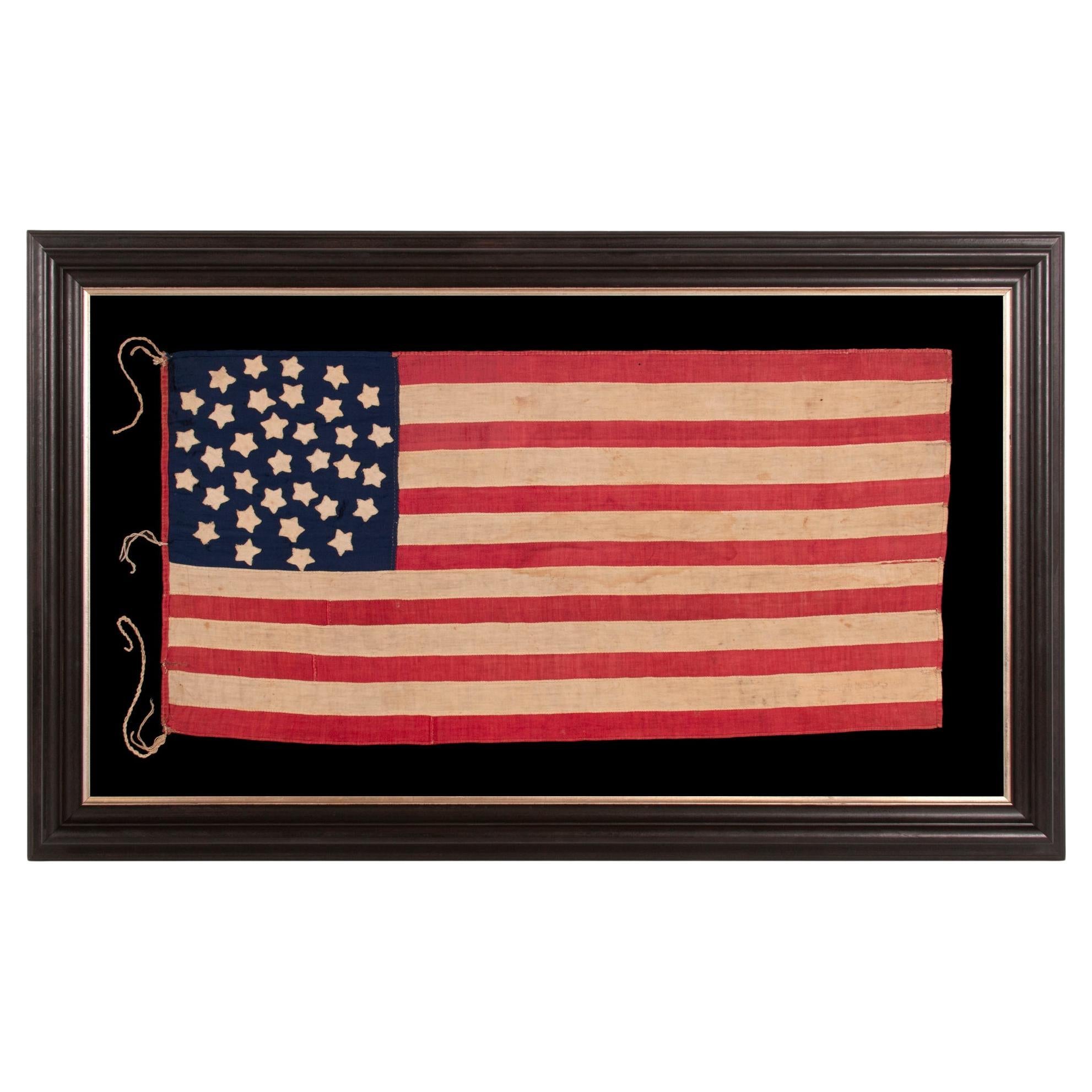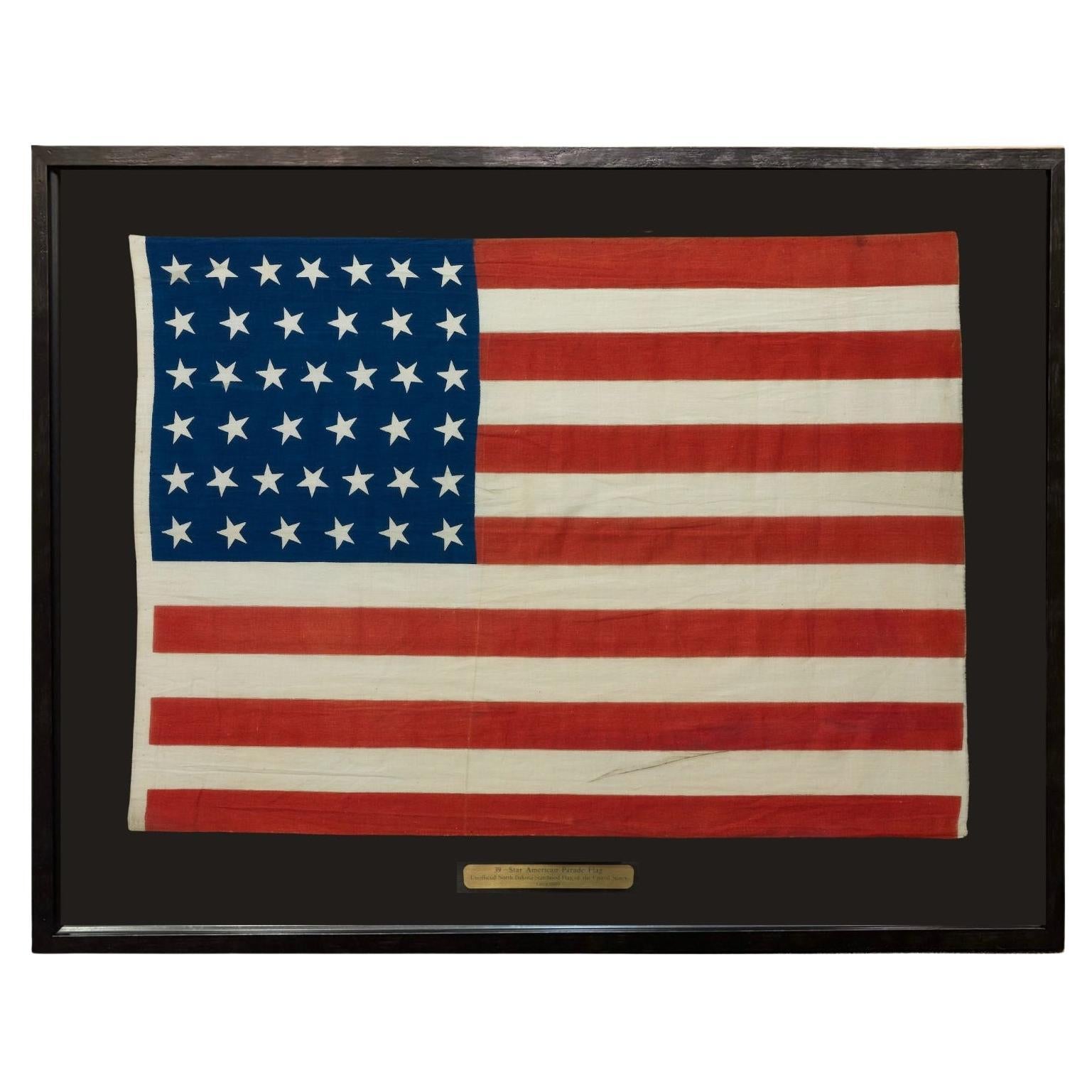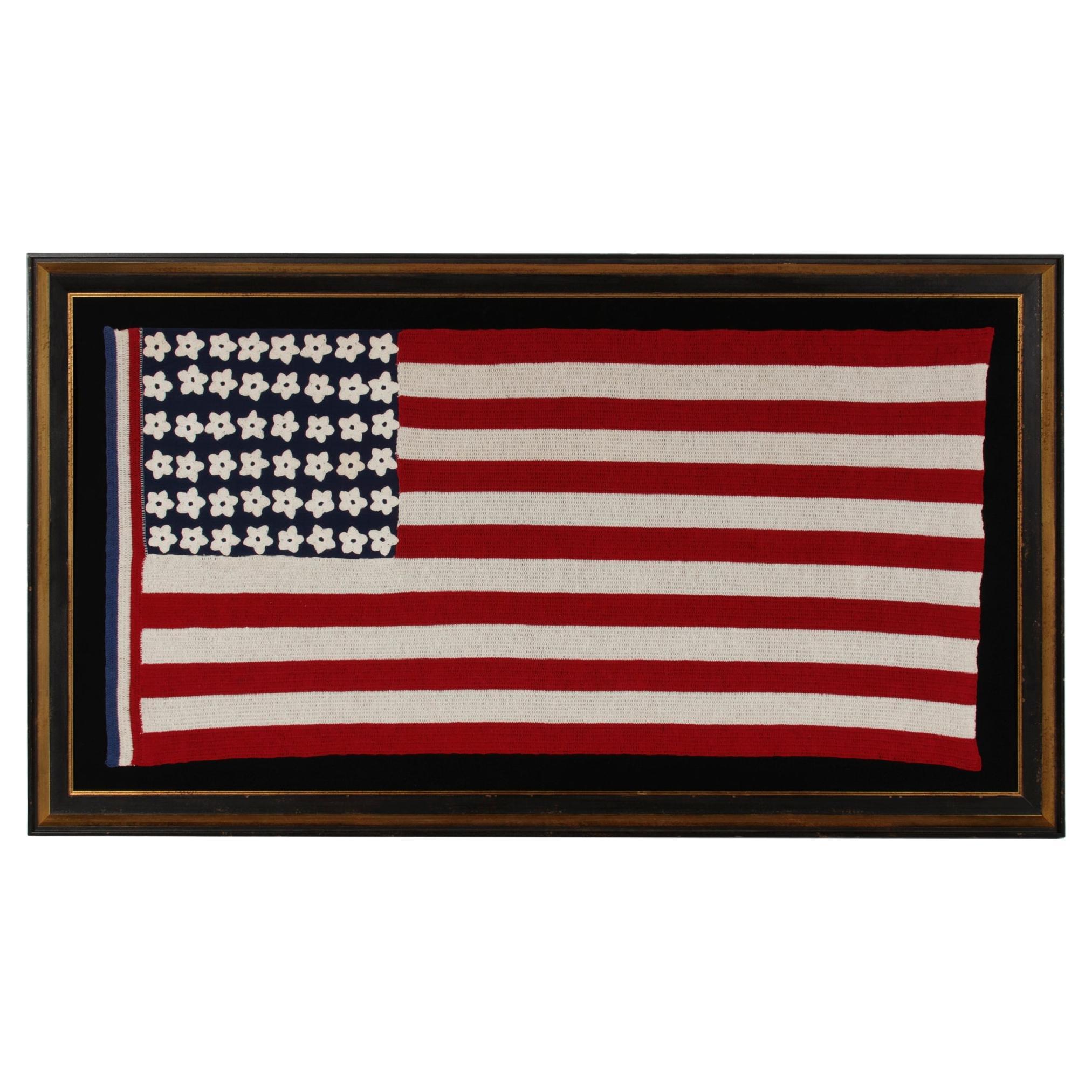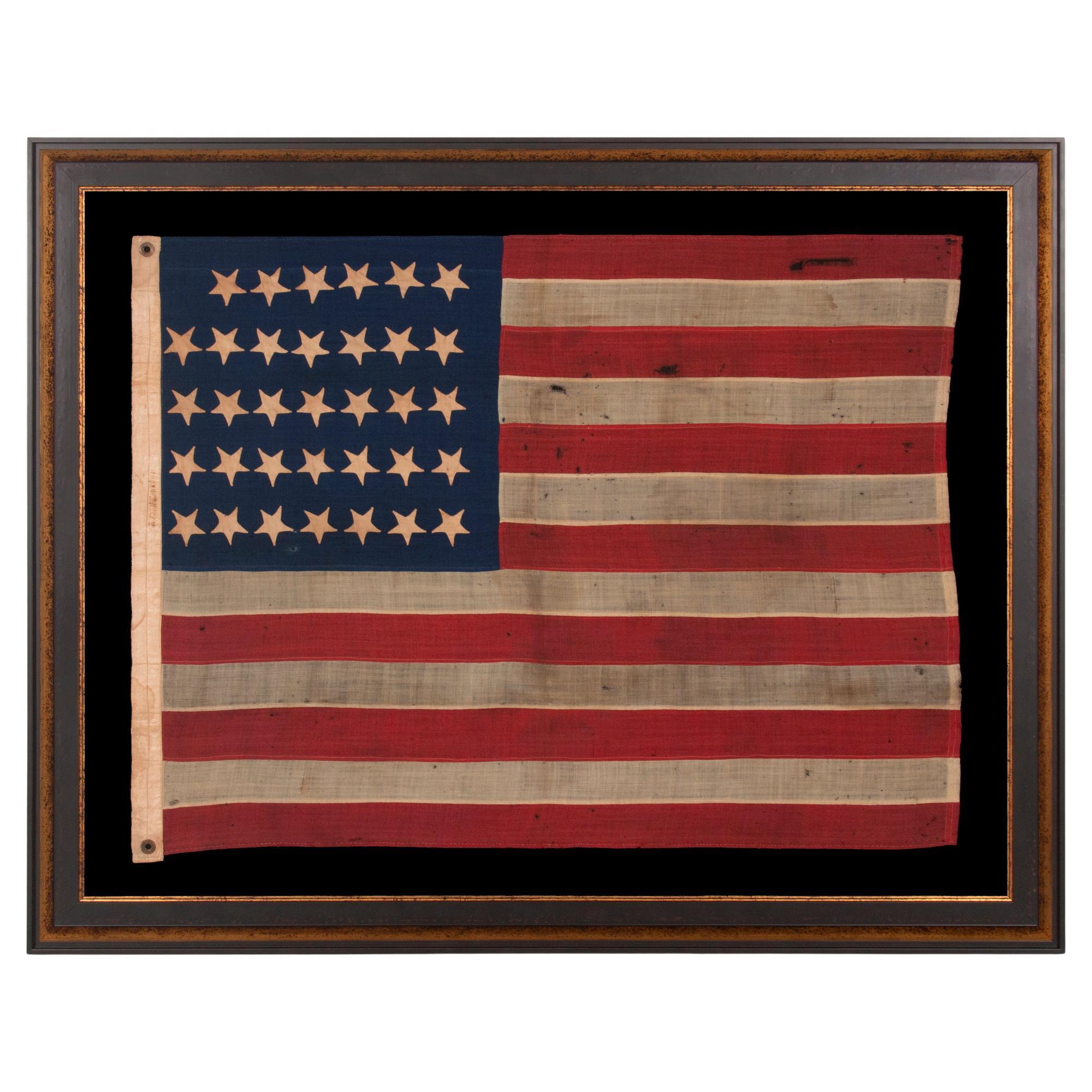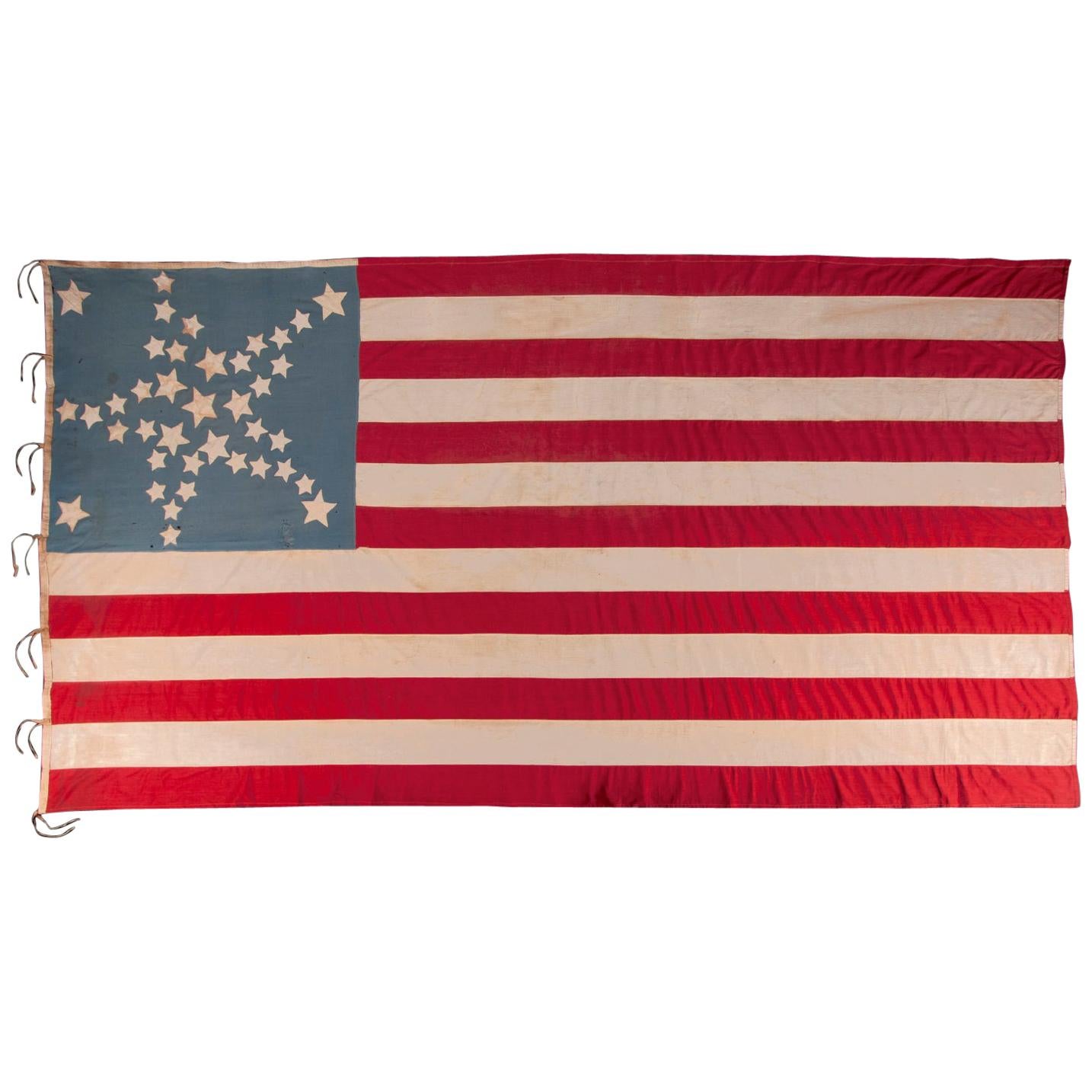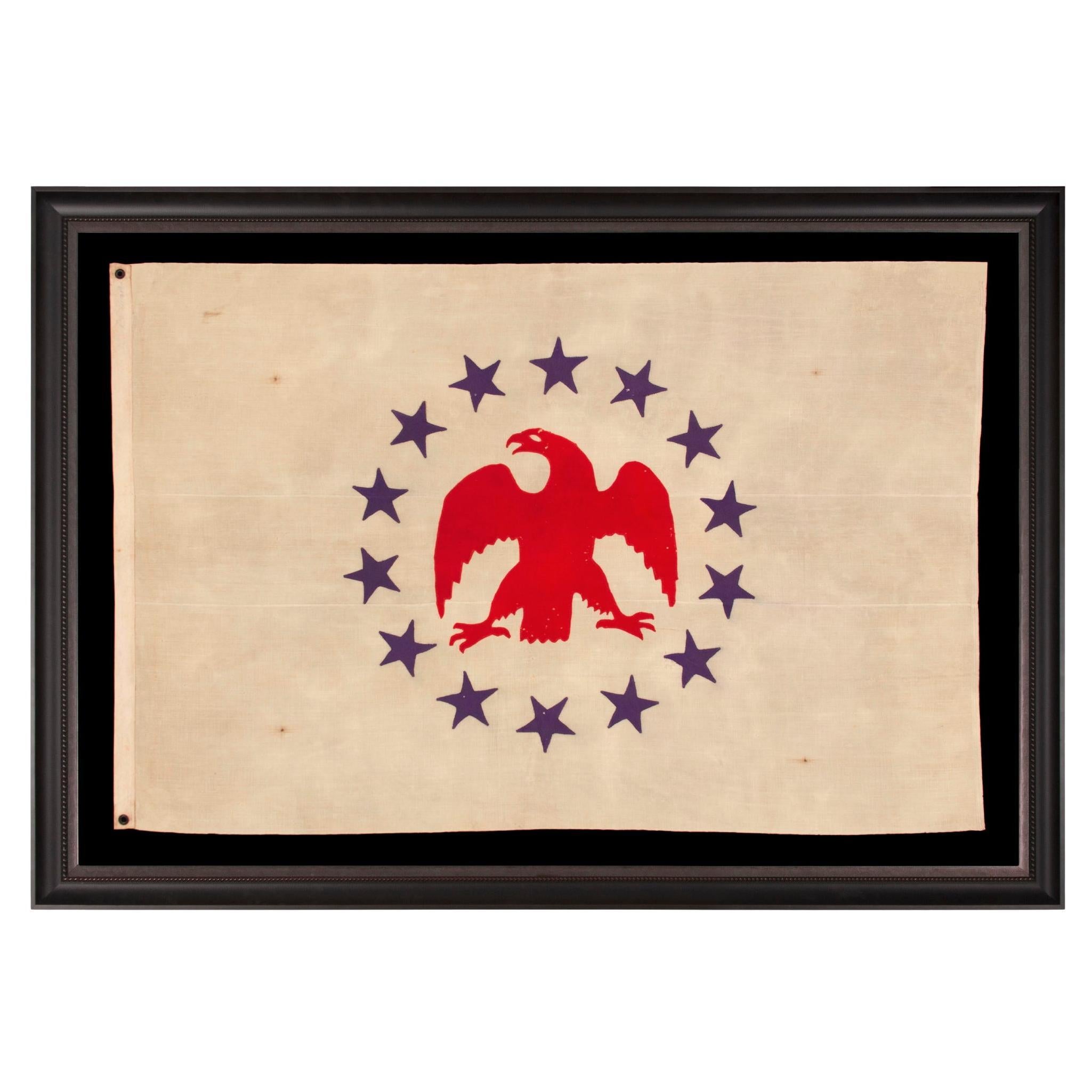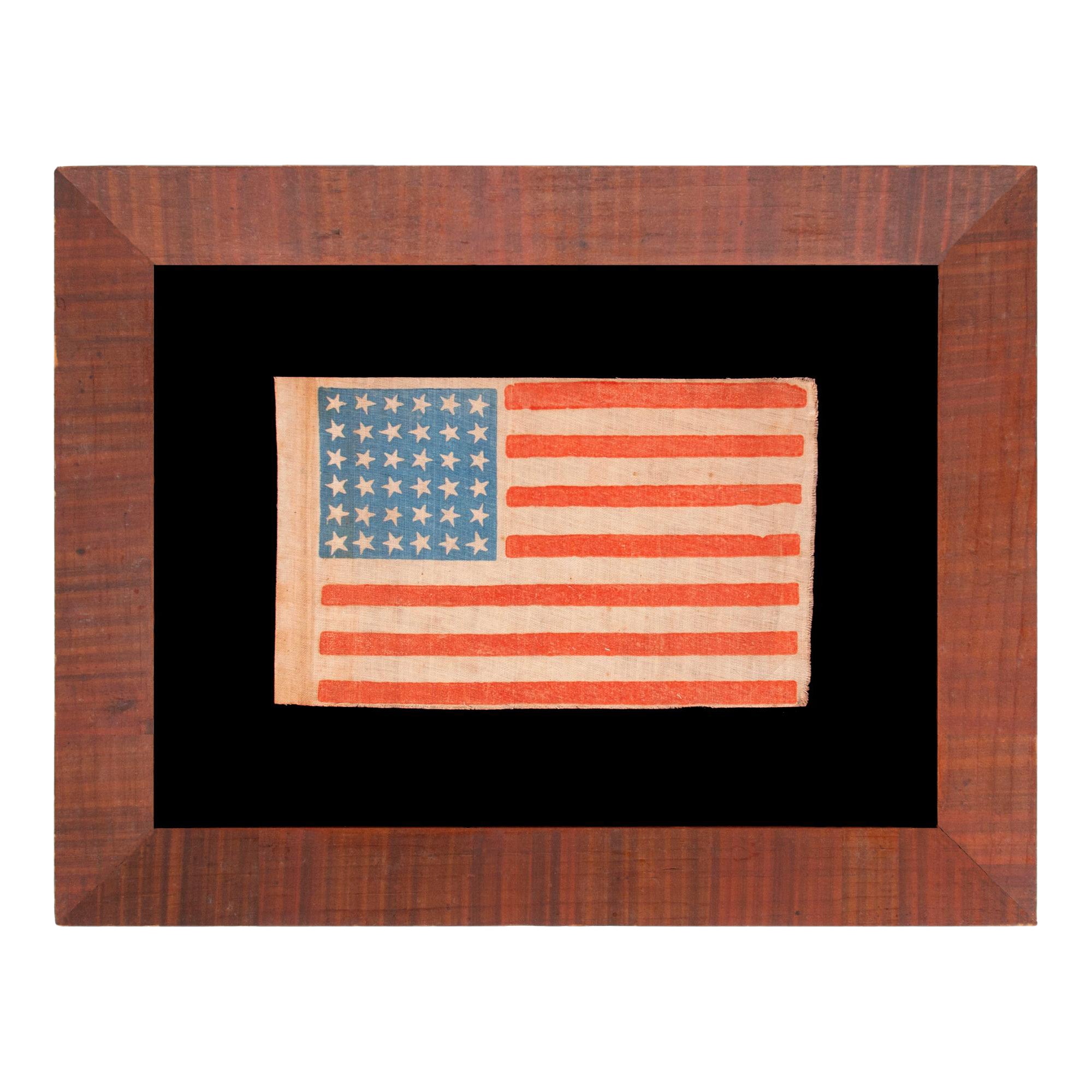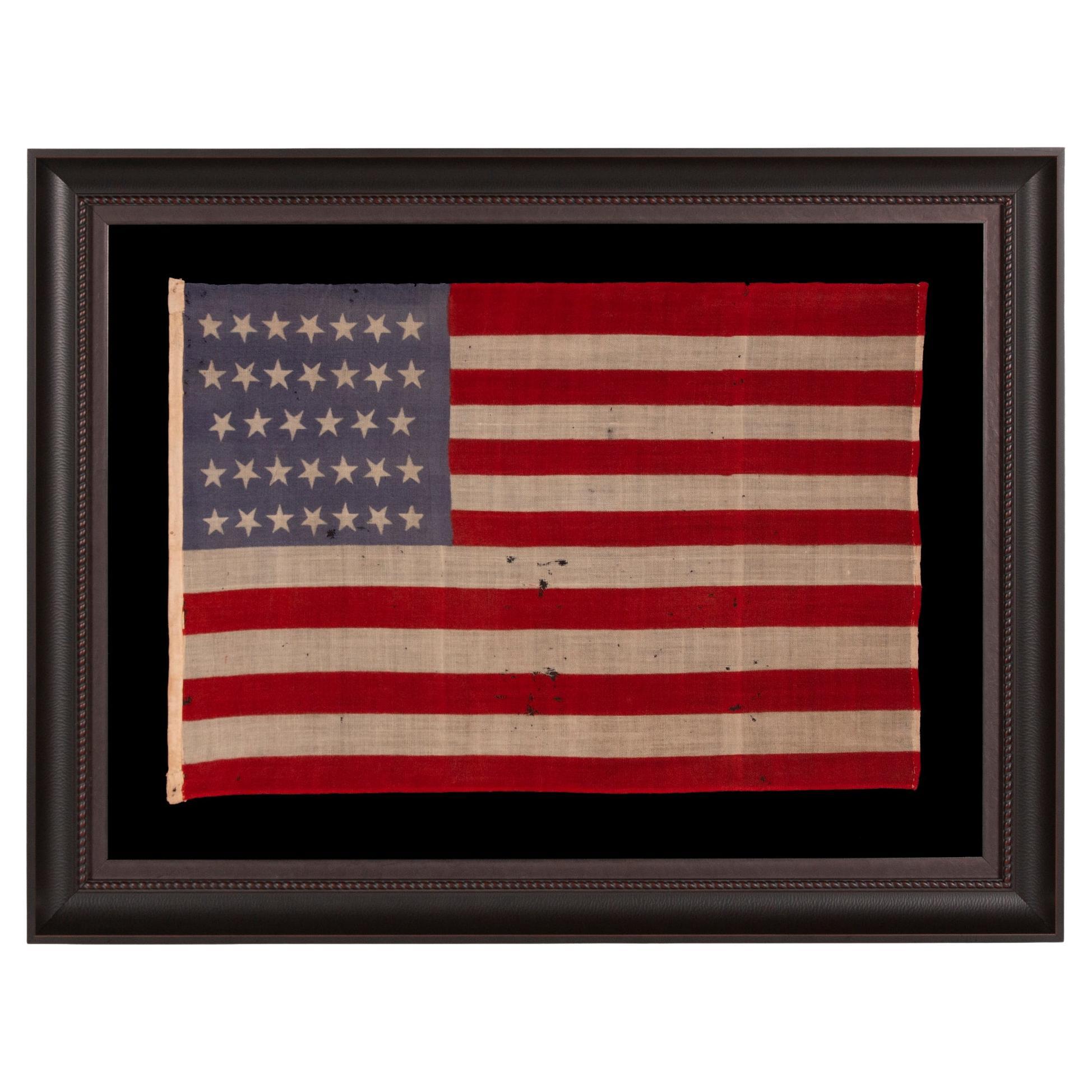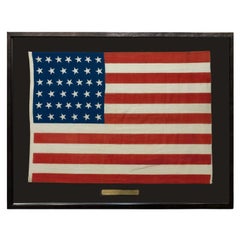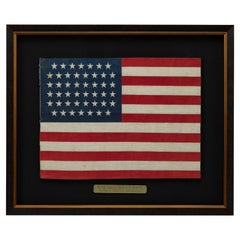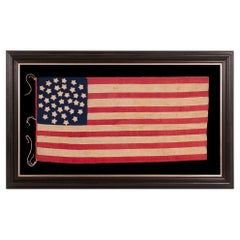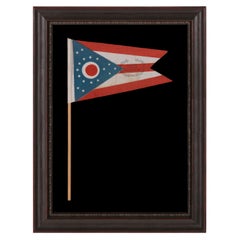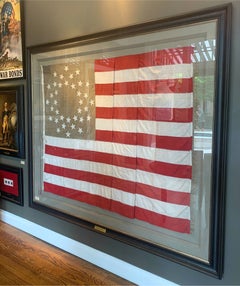
36-Star American Flag, Hand-Cut and Sewn, Civil War Era with Rare Pattern
View Similar Items
Want more images or videos?
Request additional images or videos from the seller
1 of 8
36-Star American Flag, Hand-Cut and Sewn, Civil War Era with Rare Pattern
About the Item
- Dimensions:Height: 76.5 in (194.31 cm)Width: 89 in (226.06 cm)Depth: 3 in (7.62 cm)
- Materials and Techniques:
- Place of Origin:
- Period:
- Date of Manufacture:circa 1865-1867
- Condition:Additions or alterations made to the original: Framed according to archival standards. Flag has been folded under itself, with conservation stitches holding the flag in place, to reduce overall frame size. Wear consistent with age and use. Minor losses. Minor structural damages. Minor fading. Fading to canton. Some soiling and staining visible in white stripes.
- Seller Location:Colorado Springs, CO
- Reference Number:Seller: F1891stDibs: LU909711814853
About the Seller
4.9
Gold Seller
Premium sellers maintaining a 4.3+ rating and 24-hour response times
Established in 2010
1stDibs seller since 2011
443 sales on 1stDibs
Authenticity Guarantee
In the unlikely event there’s an issue with an item’s authenticity, contact us within 1 year for a full refund. DetailsMoney-Back Guarantee
If your item is not as described, is damaged in transit, or does not arrive, contact us within 7 days for a full refund. Details24-Hour Cancellation
You have a 24-hour grace period in which to reconsider your purchase, with no questions asked.Vetted Professional Sellers
Our world-class sellers must adhere to strict standards for service and quality, maintaining the integrity of our listings.Price-Match Guarantee
If you find that a seller listed the same item for a lower price elsewhere, we’ll match it.Trusted Global Delivery
Our best-in-class carrier network provides specialized shipping options worldwide, including custom delivery.More From This Seller
View All39-Star Antique American Flag with 'Whimsical' Star Pattern, 1889
Located in Colorado Springs, CO
This is a 39-star unofficial American flag, handmade and printed on cotton. The flag dates to 1889 and has a unique history, thanks to its rare star-count.
The flag’s canton is prin...
Category
Antique 1880s American Political and Patriotic Memorabilia
Materials
Cotton
46-Star American Flag Printed in Drum Star Configuration
Located in Colorado Springs, CO
This is an original 46-Star American parade flag, celebrating Oklahoma statehood. Each star on the flag's canton represents a state in the Union at the time. The official flag design would update every July 4th, to include any new states added to the Union in the past year. Oklahoma, the 46th state, entered the Union on November 16, 1907. As such, this 46–star flag was the official flag of the United States from July 4, 1908, until July 4, 1912.
The silk flag has a dark blue canton with 46 white printed stars. The stars are printed in an 7-8-8-8-8-7 row configuration, or “Drum design.” The flag design is completed with 13 alternating red and white stripes, each stripe representing one of the original thirteen colonies.
The land that comprises Oklahoma today was added to the United States as part of the Louisiana Purchase of 1803. Throughout the 19th century, the U.S. government relocated Indian tribes from the southeastern United States to the area, and by 1900, over 30 Indian tribes had been moved to what was originally called the Indian Territories. At the same time, ranchers in Texas began to move into the area in search of new pasture lands. Although stipulations in the Indian Relocation Act agreed that the land would forever be Indian Territory, the promise of fertile farmland trumped the government’s promise of sovereignty.
On April 22, 1889, they opened the land to settlement by homesteaders, creating a land run in which settlers, called “Boomers,” were allowed to cross the Texas or Arkansas border at a particular hour to claim homesteads. Settlers who illegally crossed the border earlier to stake prime land were called “sooners,” which eventually became the state’s nickname. Wagons and the Santa Fe railroad carried cartloads of men and women to blank town sites and building plots, creating ten thousand-people communities in a matter of days. The following year, the region was further divided into Indian Territory and Oklahoma Territory...
Category
Vintage 1910s American Political and Patriotic Memorabilia
Materials
Silk
38-Star Antique American Flag with Unique Canton, circa 1876-1890
Located in Colorado Springs, CO
This is a striking 38-star American flag. The flag dates to 1876-1890, when Colorado (represented by the large star in the center of the flag’s canton) joined the Union as the 38th s...
Category
Antique Late 19th Century American Political and Patriotic Memorabilia
Materials
Muslin
46-Star Printed American Flag Waver, Celebrating Oklahoma Statehood
Located in Colorado Springs, CO
Presented is an American flag waver with 46 stars. The printed flag features a row pattern of stars against a dark blue canton, with thirteen red and white stripes completing the des...
Category
Antique Early 1900s American Political and Patriotic Memorabilia
Materials
Fabric
31-Star Printed American Flag, Celebrating California Statehood, Circa 1850
Located in Colorado Springs, CO
This is a rare 31-star medallion printed American flag, celebrating the addition of California to the Union. The flag is printed on silk and has a spectacular “Great Star” canton pat...
Category
Antique 1850s American Political and Patriotic Memorabilia
Materials
Silk
48-Star Printed American Flag, Commemorating Arizona Statehood, 1912-1958
Located in Colorado Springs, CO
This is an original 48-star American parade flag, celebrating Arizona statehood. A wonderful product of our nation's early history, this flag is an authentic antique, with a fly date...
Category
Mid-20th Century American Political and Patriotic Memorabilia
Materials
Fabric
You May Also Like
13 Star Antique American Flag , Hand-Sewn Stars in a Medallion, 1876 Centennial
Located in York County, PA
13 STAR ANTIQUE AMERICAN FLAG WITH A MEDALLION CONFIGURATION OF HAND-SEWN STARS AND A BEAUTIFUL, ELONGATED PROFILE, MADE IN THE ERA OF THE 1876 CENTENNIAL OF AMERICAN INDEPENDENCE, I...
Category
Antique 1870s Political and Patriotic Memorabilia
Materials
Wool
Outstanding 13 Star Hand-sewn American Private Yacht Flag, ca 1865-1885
Located in York County, PA
OUTSTANDING, 13 STAR, ANTIQUE AMERICAN PRIVATE YACHT ENSIGN WITH GREAT FOLK QUALITIES THAT INCLUDE AN UNUSUALLY WIDE ANCHOR AND A DECIDEDLY LOPSIDED RING OF 13 STARS; MADE DURING THE 2ND HALF OF THE 19TH CENTURY; ITS DEVICE HAND-SEWN AND SINGLE-APPLIQUÉD
Private yacht ensigns were approved American signals for maritime use that allowed pleasure boats to bypass customs. Though the legislation that approved them was adopted prior to 1850, almost all such flags that one will encounter were sewn by electric machine and made during the 20th century. The unusual gems among surviving examples are those that are earlier and include hand-sewn elements. Even more rare are a select few with atypical graphics. Barely any fall into both of these categories at once. Take note of the anchor on this particular flag, wide a long horizontal crossbar (stock) that contributes to uncommonly wide stance. Set within a ring of stars that is decidedly lopsided, the result is as bold as it is endearingly whimsical—two of the best qualities in American folk art, a category in which this particular example can be filed. While I have owned 13 star private yacht flags that have displayed star and canted anchor devices that were somewhat larger and/or bolder than typical, I cannot recall any that were so graphically intriguing as this one.
Brief History of Private Yacht Ensigns:
The medallion configuration, 13-star, 13-stripe flag, with a canted center anchor was entered into official use in 1848, following an act of Congress, that made it the official signal for U.S. pleasure sailing vessels. The need for such a flag arose with the popularity of boating as a pastime for well-to-do Americans, and as a competitive sport, in addition to its longstanding utilitarian role as a vehicle of trade. In early America, all boats were subject to customs searches at every port. Without modern income tax, the federal government derived its revenues mostly from tariffs, so an accounting of foreign goods on ships was a critical venture. As yachting for pleasure became more prevalent, however, more and more time was spent searching boats that had no such inventory, wasting time for both customs officials and wealthy ship owners.
John Cox Stevens, a former president of the Jockey Club and future founder of the Union League Club, became the New York Yacht Club’s Commodore upon its founding in 1845. In 1847 he approached the secretary of the treasury and suggested that something be done to streamline the customs process for non-trade vessels. In 1848, legislation passed Congress requiring registration of these boats, which could then fly the “American Yachting Signal” to bypass customs. This remained on the books until the 1980’s, when the 1848 legislation was revoked, but the use of flags in this design for decorative function continues to this day.
13 star flags have been flown throughout our nation’s history for a variety of purposes. In addition to their use on private yachts, they were hoisted at patriotic events, including Lafayette’s final visit in 1824-25, the celebration of the nation’s centennial in 1876, and the sesquicentennial in 1926. They were displayed during the Civil War, to reference past struggles for American liberty and victory over oppression, and were used by 19th century politicians while campaigning for the same reason. The U.S. Navy used the 13 star count on small boats until 1916, because it was easier to discern fewer stars at a distance on a small flag. Commercial flag-makers mirrored this practice and some private ships flew 13 star flags during the same period as the Navy.
Construction: The stars and anchor are made of cotton, hand-sewn, and single-appliquéd. This means that they were applied to one side of the canton, then the blue fabric was cut from behind each star, folded over, and under-hemmed, so that one star could be viewed on both sides of the flag. I always find single-appliquéd stars more interesting, not only because they are evidence of a more difficult level of seam-work and stitching, but also because they are more visually intriguing. The two visible rows of hand-stitching emphasize their hand-sewn construction. For these reasons, single-appliquéd stars often appeal to connoisseurs of early American textiles...
Category
Antique Mid-19th Century American Political and Patriotic Memorabilia
Materials
Wool
Price Upon Request
34 STAR AMERICAN FLAG, CIVIL WAR, 1861-63, KANSAS STATEHOOD, 2nd KY CAVALRY
Located in York County, PA
34 STAR ANTIQUE AMERICAN FLAG OF THE CIVIL WAR PERIOD (1861-63), IN A TINY SCALE AMONG PIECED-AND-SEWN FLAGS OF THE PERIOD, WITH A TRIPLE-WREATH CONFIGURATION, AN ELONGATED FORMAT, AND ENTIRELY HAND-SEWN; FOUND WITH A LETTER FROM JOHN W. RUDE OF THE 2ND KENTUCKY VETERAN VOLUNTEER CAVALRY (UNION):
34 star flag of the Civil War period with a variety of extremely desirable features, handed down with a letter written by John W. Rude on November 8th, 1864, while encamped with the Army’s 1st Brigade, 3rd Division, as a member of the 2nd Regiment of Veteran Volunteer Cavalry. Tiny in scale among pieced and sewn examples, the flag displays a star pattern that consists of a three consecutive wreaths, with a single star in the very center. Because it lacks a single star in each corner, outside the basic pattern—usually present in flags of this design made during the mid-late 19th century—this is something I classify as a “snowball medallion.” Entirely hand-sewn throughout, note the square format of the blue canton, with its beautiful, circular star arrangement, and how interesting this combination is when paired with the elongated format of the flag itself. The stars are double-appliqued, meaning that they are applied to both sides. These are fat in shape and inconsistent in size. Note how the lowest star in the outermost ring actually dips into the white stripe below.
Made of plain weave cotton, there is a narrow binding along the hoist, red in color, with three sets of cotton ties. Those at the top and bottom are made of fine, braided hemp or hemp and cotton cord, stitched into place, while the one in the center, looped around the binding and tied, is made of lightweight, twisted, cotton thread. Note how the 5th, 6th, and 7th red stripes are pieced from two lengths of cotton fabric, which reflects that the maker was being conscious of conserving available fabric.
In the 19th century, most flags with pieced and sewn construction were 8 feet long and larger. A six-footer was considered small. Even military battle flags, carried on foot, measured 6’ x 6.5’, which translates into approximately 7’ x 7.5’ after framing, about the size of an average quilt and larger than can comfortably fit on a wall in a house with 8-foot ceilings and average width baseboard. Flags smaller than this exist, but the smaller they get, the more unusual they are. At just 1.5’ x 3’, this is about as small as one will ever encounter in a sewn flag of the Civil War era.
The flag appears to have likely been hand-carried. I expect that it probably saw military use of some sort as a camp flag...
Category
Antique 1860s American Political and Patriotic Memorabilia
Materials
Cotton
Ohio State Parade Flag with a Civil War Veterans Overprint
Located in York County, PA
OHIO STATE FLAG WITH CIVIL WAR VETERANS' OVERPRINT FROM THE GRAND ARMY OF THE REPUBLIC POST IN COLUMBUS, MADE IN MOURNING OF THE 1925 PASSING OF NATIONAL G.A.R. COMMANDER IN CHIEF DANIEL M. HALL, WHO ALSO SERVED AS COMMANDER OF THE OHIO DEPARTMENT OF THE G.A.R., AS WELL AS THE LOCAL CHAPTER
Flag of the State of Ohio, printed on oilcloth-like cotton, affixed to its original wooden staff. Made for Civil War veteran's use, the flag bears a stamped overprint in the striped field that consists of an open wreath of laurel branches, inside which is the following text: “GAR [Grand Army of the Republic] Post, Dan Hall, Columbus, OH”.
Born on October 20th, 1842, Daniel M. Hall enlisted with the Union Army as a Private at the age of 18 on August 25th, 1861. On October 8th of that year he mustered into the Co. H of the 2nd Ohio Cavalry. Discharged for disability on June 28th, 1862, he reenlisted approximately 17 months later, on November 11th, 1863, and mustered into Co. F of the 12th Ohio Cavalry at Camp Cleveland. He was at some point promoted to the rank of Sergeant, and, on February 21st, 1864, to the rank of Corporal. He mustered out at Nashville on November 14th, 1865.
Hall mustered into the Hamlin Post of the Ohio G.A.R. on May 23rd, 1883. He would go on to serve not only as Commander of the Dept. of Ohio for the organization, but as National Commander of the entire Grand Army of the Republic.
The Grand Army of the Republic was the primary veterans association for Union Civil War soldiers. Founded in 1866, its members dressed up in Civil War uniforms, attended parades and reunions, and the organization was somewhat more fraternal in nature than today’s VFW or American Foreign Legion.
Flags overprinted for the purpose of advertising are a specialized form in American flag collecting. A flag with a basic G.A.R. overprint is the most common type. This might be accompanied by a post number and a date. More elaborate the overprints are more highly desired, such as this one, which is the only variation I know of that honors a particular person who was not the namesake of the chapter itself.
It is of interest to note that a sister variety of 48 star parade flag is known, printed on the same fabric, that bears the same overprint, accompanied by the words: “We Mourn Our Comrade." From the additional text on the 48 star variety, one can extrapolate that the flags were made to mourn the passing of this important leader of Civil War veterans on October 19th, 1925, just one day before his 83rd birthday.
The State Flag of Ohio was designed in 1901 by Cleveland architect John Eisenmann, who designed the Ohio building for the state's exhibition at the Pan American Exposition World's Fair in Buffalo, New York. It was officially adopted by the Ohio legislature on May 19th, 1902. It's elements are centered on a red disc, set against a circular white ground that forms a letter "O." This simultaneously represents a buckeye, the fruit of the state tree and an iconic Ohio symbol. The flag's 5 stripes are said to represent the state's waterways and roads, while the triangular shape of the union is said to illustrate hills and valleys. The presentation of 13 stars along the hoist end, arranged in a semi-circular medallion with two off-set stars above and below, reflects the original 13 colonies. The diamond of stars, towards the fly end. bring the overall count to 17 to reflect Ohio's admission. When the design was adopted by the state legislature, the position of these stars was changed slightly, moving them further around the circle to form a wreath.
Flag expert Whitney Smith, who coined the term Vexillology in the late 1950's (the accepted term for the study of flags), pointed out that the format of the flag itself was reminiscent of Civil War cavalry guidons, carried by Ohio regiments throughout the state. These were of swallowtail form, though with 13 stripes, all horizontal and 90 degrees to the hoist. Most often these had circular star patterns around an open center, which makes them even more similar to the Ohio flag...
Category
Vintage 1920s American Political and Patriotic Memorabilia
Materials
Cotton
1862 Civil War Playing Cards with Stars, Flag, Sheilds and Eagles
Located in York County, PA
1862 Civil War playing cards with stars, flags, shields, & eagles, and face cards illustrating civil war officers and lady, Columbia, ca 1862, Benjamin Hitchcock, New York
1862 Civil War playing cards with suits represented by stars, flags, shields, & eagles, in lieu of the traditional French suits of hearts, diamonds, clubs, and spades. The face cards feature Union Army officers and Lady Columbia [a.k.a. Lady Liberty, Goddess of Liberty]. Entitled “Union Playing Cards,” two versions of this deck were produced in New York by Benjamin W. Hitchcock’s “American Card Company.” This is the earlier of the two. The other was released in 1863.
There are 52 cards in total with the ace of spades doubling as the title card, as was often the case during the 19th century. The telescoping box...
Category
Antique 1860s American Political and Patriotic Memorabilia
Materials
Paper
Price Upon Request
48 Star Crocheted Homemade American Flag, WWII Era, 1941-1945
Located in York County, PA
48 star, crocheted, antique american flag of the wwii era (1941-1945), a beautiful, homemade example, with a red, white, & blue hoist and flower-like stars:
Crocheted American flag of the WWII era (U.S. involvement 1941-1945), with some interesting and beautiful features. Made entirely of cotton, the flag’s most notable attribute is the red, white, and blue color of its hoist. This was carefully stitched to the canton and the striped field with white cotton floss or yarn. The 48 crocheted stars are appliquéd to a length of navy blue plain weave cotton. With pierced centers, note how these more closely resemble flowers than stars, tipped this way and that on their vertical axis. Large, with respect to the canton on which they are placed, note how these crowd their boundaries and overlap into the field.
The elongated format of the flag is also of interest and contributes to the bold presentation, as do the strong colors. Most crocheted flags are smaller than this one, or date to a much later period (namely the 1976...
Category
Mid-20th Century American Political and Patriotic Memorabilia
Materials
Cotton
Price Upon Request
Recently Viewed
View AllMore Ways To Browse
Cleveland Memorabilia
Cleveland Browns Memorabilia
Abraham Lincoln Memorabilia
Used Flags
Red And White Stripes
American Antique Furniture Makers
Furniture With Black And White Stripes
Stains V
20th Century Flags
American Flag Framer
Warring States Period
Civil War Period
Antique American Textiles
Used American Flags
Patriotic Antique
Stitched Stripes
Star Wars Furniture
Distressed Antique Black
